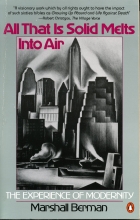
| Home News Releases | Calendar Contact |
Sources Bookshelf

All That Is Solid Melts Into Air
The Experience of Modernity
Berman, Marshall
Publisher: Penguin, New York, USAYear Published: 1988 First Published: 1982
Pages: 384pp ISBN: 0-14-010962-5
Library of Congress Number: CB425.B458 Dewey: 909.82
Please see our media profile in Sources:
Connexions Library
In All that Solid Melts into Thin Air Berman confronts the central ambiguity of modernism, the attempt by men and women to become objects of modernization in order to understand the world and cultivate it into their home. Berman creates an open-ended dialogue with the reader such that he/she may include their own experiences as an extension of the three-phased history of modernism he outlines within the book. These three historical phases of modernity begin with the first phase ranging from the 16th century to the 18th century, when human civilization is still adapting to modern life. The dichotomous second phase beginning in the 1790s, when concepts of modernity materialized, is initially characterized by a revolutionary public. In the latter half, 19th century society becomes preoccupied with a nostalgic desire to gain knowledge about non-modern civilizations. Finally, with the last phase in the twentieth century, modernity as a process embraces the entire world, yet simultaneously becomes fragmented as society no longer relates to modern art and cultural forms in a useful manner. This is because too many distinct and contradictory ways of understanding modernity render it incapable of lending meaning to people's lives. Berman attempts to address this challenge of fragmentation, caused by the advent of post-modernism in the 70s, by proposing a reappropriation of the dialectical 19th century modernists. Consequently, we will reconnect the contradictory forces of modernist society; including disjointed geographical borders, identities and cultures; that present themselves as obstacles to understanding the modern world.
Influenced by thinkers including Rousseau, Nietzsche, Marx, Baudelaire, Goethe and Kierkegaard, the initial three sections of the book examine the impact of works by modernist thinkers. In the first section we learn how Goethe's Faust expresses the modernist quest, whereas the second section questions if Marx's Communist Manifesto (the source for the book title) can account for the relationship between bourgeois economy and modernist culture. Next Berman discusses the importance of Baudelaire's art in providing nineteenth century society with an awareness of their modernity and modern art forms. In contrast, the final two sections of the book focus on geographical places that exemplify modernism. Therefore, section five discusses how Russia experienced economic underdevelopment in opposition to the West's growth. In particular, Berman examines how the imperial and cosmopolitan city of St. Petersburg is a source to explore modern life. The final section of the book illustrates how New York has simultaneously come to represent modernist ruin, modern life imagined and modern man's capacity to build.
[Abstract by Amanpreet Dhami]
Subject Headings
- Architecture
- Bourgeois Ideology
- Bourgeoisie
- Capitalism
- Capitalist Class
- Cities
- Commodity Fetishism
- Communism
- Communist Manifesto
- Contradiction
- Creation
- Creativity
- Cultural Studies
- Dadaism
- Dance
- Dialectic
- Free Trade
- Futurists
- Ghosts
- Ideological Conflict
- Ideology
- Intellectuals
- Jacobs, Jane
- Literary Criticism
- Literature
- Marx, Karl
- Marxism
- Modern Art
- Modern History
- Modernism
- Modernization
- New Left
- New York City
- Nihilism
- Nuclear Science
- Paris
- Pavement Engineering
- Post-Modernism
- Poverty
- Revolution
- Russia
- Russian Revolution
- Scientists
- Self-Consciousness
- Self-Image
- Serfdom
- Soviet Union
- Street Life
- Streetscape Design
- Traffic
- Underdevelopment
- Urban History
- Urbanization
© Sources 2023. The information provided is copyright and may not be reproduced in any form or by any means (whether electronic, mechanical or photographic), or stored in an electronic retrieval system, without written permission of the publisher.